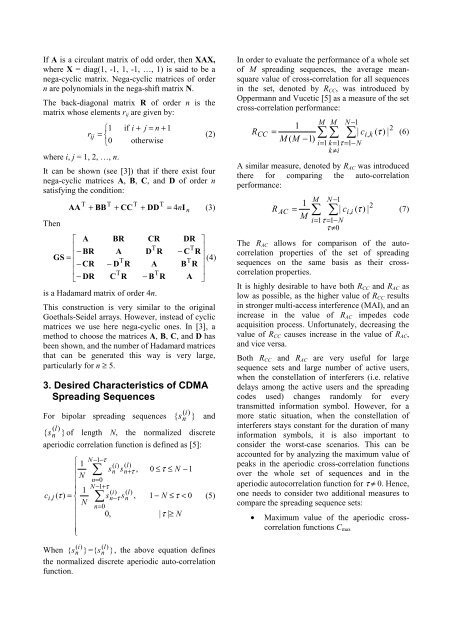Application of Nega-cyclic Matrices to Generate Spreading Sequences
Application of Nega-cyclic Matrices to Generate Spreading Sequences
Application of Nega-cyclic Matrices to Generate Spreading Sequences
You also want an ePaper? Increase the reach of your titles
YUMPU automatically turns print PDFs into web optimized ePapers that Google loves.
If A is a circulant matrix <strong>of</strong> odd order, then XAX,<br />
where X = diag(1, -1, 1, -1, …, 1) is said <strong>to</strong> be a<br />
nega-<strong>cyclic</strong> matrix. <strong>Nega</strong>-<strong>cyclic</strong> matrices <strong>of</strong> order<br />
n are polynomials in the nega-shift matrix N.<br />
The back-diagonal matrix R <strong>of</strong> order n is the<br />
matrix whose elements rij are given by:<br />
⎧ 1 if i + j = n + 1<br />
rij = ⎨<br />
(2)<br />
⎩0<br />
otherwise<br />
where i, j = 1, 2, …, n.<br />
It can be shown (see [3]) that if there exist four<br />
nega-<strong>cyclic</strong> matrices A, B, C, and D <strong>of</strong> order n<br />
satisfying the condition:<br />
Then<br />
T T T T<br />
AA + BB + CC + DD = 4nI<br />
n (3)<br />
⎡ A<br />
⎢<br />
⎢<br />
− BR<br />
GS =<br />
⎢−<br />
CR<br />
⎢<br />
⎣−<br />
DR<br />
BR<br />
A<br />
T<br />
− D R<br />
T<br />
C R<br />
CR<br />
T<br />
D R<br />
A<br />
T<br />
− B R<br />
DR ⎤<br />
T<br />
− C R<br />
⎥<br />
⎥<br />
T (4)<br />
B R ⎥<br />
⎥<br />
A ⎦<br />
is a Hadamard matrix <strong>of</strong> order 4n.<br />
This construction is very similar <strong>to</strong> the original<br />
Goethals-Seidel arrays. However, instead <strong>of</strong> <strong>cyclic</strong><br />
matrices we use here nega-<strong>cyclic</strong> ones. In [3], a<br />
method <strong>to</strong> choose the matrices A, B, C, and D has<br />
been shown, and the number <strong>of</strong> Hadamard matrices<br />
that can be generated this way is very large,<br />
particularly for n ≥ 5.<br />
3. Desired Characteristics <strong>of</strong> CDMA<br />
<strong>Spreading</strong> <strong>Sequences</strong><br />
(i)<br />
For bipolar spreading sequences { s n } and<br />
(l)<br />
{ sn } <strong>of</strong> length N, the normalized discrete<br />
aperiodic correlation function is defined as [5]:<br />
c<br />
i,<br />
l<br />
( τ )<br />
⎧ N −1−τ<br />
1 ( i)<br />
⎪ ∑ sn<br />
s<br />
⎪ N<br />
n=<br />
0<br />
⎪ N −1+<br />
τ<br />
⎪ 1 ( i)<br />
= ⎨ ∑ sn−τ<br />
s<br />
⎪ N<br />
n=<br />
0<br />
⎪ 0,<br />
⎪<br />
⎪<br />
⎩<br />
(i)<br />
(l)<br />
( l)<br />
n+<br />
τ ,<br />
( l)<br />
n<br />
,<br />
0 ≤τ<br />
≤ N −1<br />
1 − N ≤τ<br />
< 0<br />
| τ | ≥ N<br />
(5)<br />
When { s n } = { s n } , the above equation defines<br />
the normalized discrete aperiodic au<strong>to</strong>-correlation<br />
function.<br />
In order <strong>to</strong> evaluate the performance <strong>of</strong> a whole set<br />
<strong>of</strong> M spreading sequences, the average meansquare<br />
value <strong>of</strong> cross-correlation for all sequences<br />
in the set, denoted by RCC, was introduced by<br />
Oppermann and Vucetic [5] as a measure <strong>of</strong> the set<br />
cross-correlation performance:<br />
M M N −1<br />
1<br />
2<br />
RCC<br />
= ∑∑ ∑|<br />
ci,<br />
k ( τ ) | (6)<br />
M ( M −1)<br />
i=<br />
1k= 1τ=<br />
1−N<br />
k≠i<br />
A similar measure, denoted by RAC was introduced<br />
there for comparing the au<strong>to</strong>-correlation<br />
performance:<br />
−<br />
∑ ∑<br />
=<br />
≠ − =<br />
M N 1<br />
1<br />
2<br />
RAC<br />
= | ci,<br />
i ( τ ) | (7)<br />
M<br />
i 1τ<br />
1 N<br />
τ 0<br />
The RAC allows for comparison <strong>of</strong> the au<strong>to</strong>correlation<br />
properties <strong>of</strong> the set <strong>of</strong> spreading<br />
sequences on the same basis as their crosscorrelation<br />
properties.<br />
It is highly desirable <strong>to</strong> have both RCC and RAC as<br />
low as possible, as the higher value <strong>of</strong> RCC results<br />
in stronger multi-access interference (MAI), and an<br />
increase in the value <strong>of</strong> RAC impedes code<br />
acquisition process. Unfortunately, decreasing the<br />
value <strong>of</strong> RCC causes increase in the value <strong>of</strong> RAC,<br />
and vice versa.<br />
Both RCC and RAC are very useful for large<br />
sequence sets and large number <strong>of</strong> active users,<br />
when the constellation <strong>of</strong> interferers (i.e. relative<br />
delays among the active users and the spreading<br />
codes used) changes randomly for every<br />
transmitted information symbol. However, for a<br />
more static situation, when the constellation <strong>of</strong><br />
interferers stays constant for the duration <strong>of</strong> many<br />
information symbols, it is also important <strong>to</strong><br />
consider the worst-case scenarios. This can be<br />
accounted for by analyzing the maximum value <strong>of</strong><br />
peaks in the aperiodic cross-correlation functions<br />
over the whole set <strong>of</strong> sequences and in the<br />
aperiodic au<strong>to</strong>correlation function for τ ≠ 0. Hence,<br />
one needs <strong>to</strong> consider two additional measures <strong>to</strong><br />
compare the spreading sequence sets:<br />
• Maximum value <strong>of</strong> the aperiodic crosscorrelation<br />
functions Cmax

















